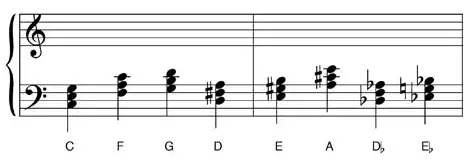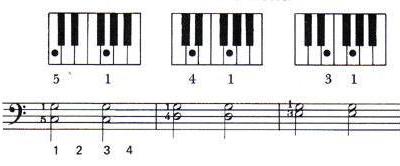
Piano Chords are nothing but a combination of notes played together. Here you will learn more about the advantages of playing chords, and the different types of chords…
Why Learn Chords
A chord is nothing but a combination of notes played together to create a rich sound. It is used primarily for harmonizing a melody.
Knowing to play chords is the first step if you want to harmonize any piece of music on your own. Harmonizing simply means adding notes below the melody note to give a far richer sound. That is the reason you need to learn piano chords!
To see how important chords are, ask somebody who can play the piano to play a song, first with chords and then the same song without chords i.e. just play the melody. See the difference that chords can make to your playing.
Chords in Vocals
Centuries back, people figured out that a group of people singing together makes a much louder / fuller sound. And the same thing when sung, with individuals singing a few notes higher or lower, produces a much more dramatic sound.
No wonder then that singing in big groups is extremely widely spread in traditional cultures.
If you get an opportunity to listen to a choir (musical ensemble of singers), don’t miss it! A good singer when singing all alone can sound sweet, but hearing an ensemble is a totally different experience.
That is the reason chords are used, to harmonize the melody so that the overall effect of the song is enhanced.

Helps in Song-Writing
Here’s how it can help, when you are creating a song!
Assuming you have created a nice melody, and also have the lyrics in place. You just can’t have drums & bass playing in the background. It might still be good enough as a demo track, but still anybody who is listening to the track will feel something is missing.
And the missing part is the tracks that usually include piano, guitar, synths & pads part that play the various chords, and which makes the song sound fuller.
Gives an Advantage in Piano Playing
Now that you know the important reason behind this, there are also other reasons why you (or your child) should learn to play chords.
If your child is learning in school, most probably chords will come in quite later. Even though your child might know the notes to play Happy Birthday, Jingle Bells, Silent Night, and many more songs, he/she can make it sound much better by using chords.
Why not get an advantage by learning to play chords?
You can make the most of your family gatherings during Christmas every year, or even at other social gatherings, and also get some admiration in return.
Learning to play just the primary chords can help you play hundreds of songs.
Have you read / heard that piano playing is good for the brain? Of course it is! After all, you are giving your brain a good work-out by learning to play those three or four note chords, and also moving from one to another smoothly.
Types of Chords
Basic Chords
Are you an absolutely beginner student learning to play the piano? Let us look at some of the most commonly used chords.
Everybody starts with these Piano chords! A basic chord is nothing but a combination of three notes and derives its name from the name of the bottom note, also known as the Root Note. Some of the popular basic chords are – Major, Minor, Diminished and Augmented.
You will need to learn to play these chords as well as hear the difference between each of these different types. For Major and Minor chords, you will also have to learn to play the various chord inversions.
If you are totally new to chords and are not sure on how to play, then you better watch these videos carefully. You can pause and watch them over if you are not sure.
There is nothing to be intimidated about chords. It’s like learning any new music concept. With practice you too will be able to play piano chords.
Other Chords
Most of the other chords are derived from the basic chords by adding more notes to it. These chords have more than 3 notes, where the first three notes remain the same as in the basic chord. To begin with you need to learn the basic chords and then gradually move onto these chords.
There are lots of chords that can be derived from the basic chords but these are some of the most commonly used chords – Sixth chord, Major seventh chord, Seventh chord, Minor seventh chord. The seventh chord is something which you can look to learn before the other chords since it is used as part of a cadence i.e. as part of the chord progression to end a song.
Piano Chord Chart to Remember Various Types of Chords
There are various kinds of chords that you can play while harmonizing a song and each of the chords has its own construction rules. You may find it a bit difficult initially to remember the different types of chords and as such a reference chart may be helpful. The piano chord chart below shows the construction rules for the most commonly used chords.
| Chord Type | Chord Symbol | Scale Notes Used |
| Major | C | 1 – 3 – 5 |
| Minor | Cm | 1 – 3b – 5 |
| Augmented | C+ | 1 – 3 – 5# |
| Diminished | Cdim | 1 – 3b – 5b |
| Suspended fourth | Csus | 1 – 4 – 5 |
| Sixth | C6 | 1 – 3 – 5 – 6 |
| Minor Sixth | Cm6 | 1 – 3b – 5 – 6 |
| Seventh | C7 | 1 – 3 – 5 – 7b |
| Major Seventh | Cmaj7 | 1 – 3 – 5 – 7 |
| Minor Seventh | Cm7 | 1 – 3b – 5 – 7b |
| Diminished Seventh | Cdim7 | 1 – 3b – 5b – 6 |
How to Play Piano Chords: Videos
If you are totally new to chords and are not sure on how to play, then you better watch these videos carefully. You can pause and watch them over if you are not sure.
There is nothing to be intimidated about chords. It’s like learning any new music concept. With practice you too will be able to play piano chords.
Piano Chord Inversions
The construction of Major and Minor chords that we discussed above focused on the root position i.e. the lowest note was the same as the name of the chord.
Piano Chord Inversions is about rearrange the sequence of the notes in the chord.
You don’t always have to play a chord in the root position. You can rearrange the notes of a chord in a different order. When you do that, the chord is said to be “inverted”.
Example
The notes of C Major chord, played in the Root position, would be C E G.
Now this same chord can be played in different inverted forms.
E G C – First Inversion
G C E – Second Inversion
As you can see here, the C Major chord can also be played in two inversions.
Uses
So what is the use of knowing chord inversions? The most important use is that you can easily move from one chord to another, with minimum shifting of your hands. For instance, if you have to move from C Major chord to A Minor chord, you only need to move one note. Let us see how!
C Major (Root position) – C E G
A Minor (First Inversion) – C E A
So you can clearly see the advantage of using chord inversions here – minimum hand movement! Now you need to go back and learn the inversions for all the Major & Minor chords 🙂
Basic Piano Chords – Learn to play the D Major and D Minor chords
Here’s how to play the D Major and D Minor chords on the piano.
Learn How To Play Piano Chords: Techniques
Here we take a look at the different ways you can use chords to accompany a melody.
In the simplest form, you play a piano chord with your left hand while your right hand is busy playing the melody. Pros play chords with both their hands, with the melody becoming the top note of the chord played on the right hand.

Can’t Play with Both Hands…Help
One common question that most students ask is “I’m not able to play the piano with both my hands together”. This is when students start using their left hands to play piano chords along with their right hand which plays the melody.
The answer to this question is to keep the following in mind.
- Learn both the hands separately
- Slow down the tempo while learning
- Break the song into smaller chunks and learn
I Don’t Have Large Hands
Another common question (this is more of a concern) that students ask is that they don’t have large hands. So how can they play piano chords?
While this may be true for most students (especially with women), you really don’t need big hands to be able to play piano chords.
Besides, you always start with the simple chords first. There is no point attempting to play a tenth chord when you don’t know how to play a seventh.
Over a period of time, with more practice, your fingers stretch more. Even otherwise, you will be able to find alternatives (chord inversions) if you are not able to stretch your hands to play a chord in a particular position.
How To Play Piano Chords: More Suggestions
Here are some suggestions on how to play piano chords.
- Arpeggios/Broken Chords
An easy way of playing chords is to play the notes of a chord in an arpeggiated manner i.e. play arpeggios with your left hand. Play a constant up and down pattern to accompany the melody. - Fixed/Block Chords
Another easy method of playing chords is to play straight chords i.e. all the notes together, you can choose to play the chords in the root position or use any of the inversions. You will need to try out various rhythmic patterns while playing in this style. - Chord Picking
Play the chords in a pattern that alternates between the bass note and the remaining two notes i.e. play the root note on one beat and the other two notes together on the next beat. Keep on repeating the same pattern. - Right Hand Chords
This is an advanced way of playing chords where you play chords with both the hands, with the melody note becoming the top note of the chord played on the right hand.
Chords can be used in many different ways but these are some of the methods that should answer most of your queries on how to play piano chords. Start using them right away!
More on Piano technique
Learn to Play Piano the Right Way with these popular piano learning software
More Free Piano Lessons here
Back to Home page from Piano Chord Inversions
KeytarHQ editorial team includes musicians who write and review products for pianists, keyboardists, guitarists & other musicians. KeytarHQ is the best online resource for information on keyboards, pianos, synths, keytars, guitars and music gear for musicians of all abilities, ages and interests.



Leave a Reply